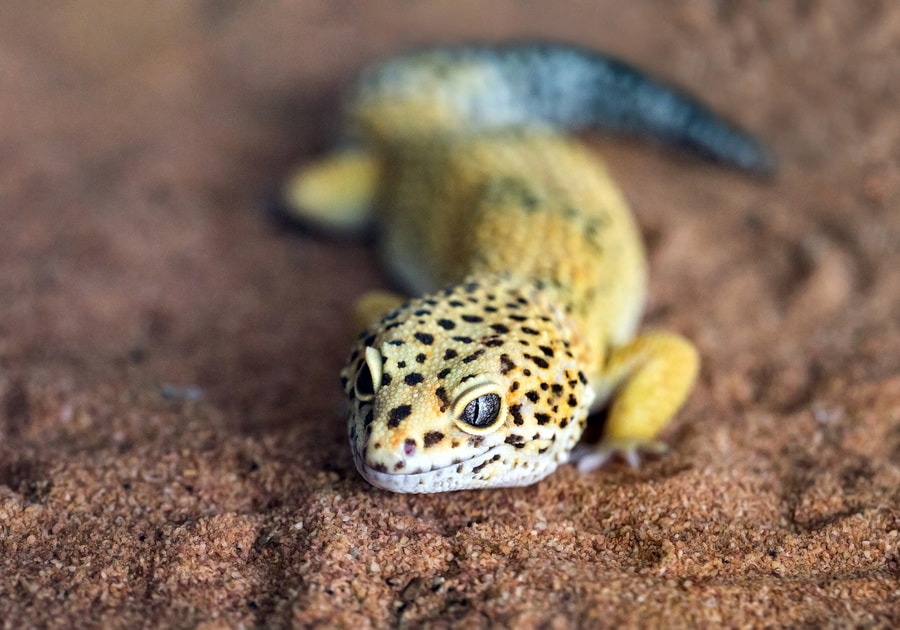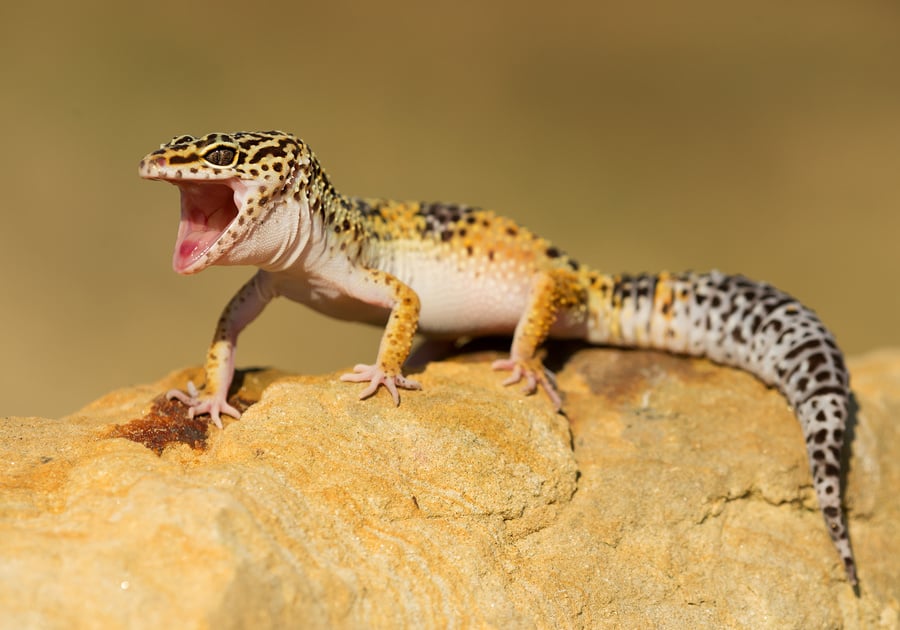
Whether choosing the correct light colors, considering the design of the terrarium, or even contemplating if their pet’s food should be dyed, leopard gecko owners may wonder whether their scaly friends can see color at all.
Leopard geckos can see in color, although they are more limited than humans are. With this color vision, they have interesting traits—including the ability to see color in the dark.
In this article, we are really going to dive into the basics of leopard gecko vision, their abilities to see color, movement, and in low-light conditions, as well as some common eye issues they can develop.
Vision & Leopard Geckos
Can Leopard Geckos See Color?
Although they may not see as many colors as humans do, leopard geckos can certainly see in color because of the presence of cones in their eyes. More specifically, leopard geckos are the most sensitive to blue and green colors. Interestingly, they cannot see the color red.
During the daytime, leopard geckos should have a standard incandescent light. Colored light (more specifically, yellow and red because they are less sensitive to these colors) is better than super bright light (such as blue and green). As a matter of fact, because leopard geckos are so sensitive to the color blue, lightbulbs with this coloration can cause eye damage if the leopard gecko is exposed to it for extended periods of time.
As a side note, UVA light during the daytime can help with the leopard gecko’s eyesight, so it may be a worthwhile investment. At night, the leopard gecko should not have colored night lights, only using heat mats and ceramic heat bulbs to keep warm.
This is because leopard gecko eyes are highly sensitive to light. They should not even have a red-colored bulb because even though they cannot see the color red, leopard geckos can still see the light emitted from the bulb. However, leopard geckos can have these lights on for a couple of hours before you go to sleep if you wish to keep an eye on your pet.
Why should leopard geckos not have any light bulbs on at night? Because of its sensitivity to light, the leopard gecko’s sleep schedule can easily be disturbed if it believes that it is too light to be nighttime. (However, because they are active at night, leopard gecko owners should have a dim source of light not directly shining on the cage, i.e., a dim light in the hallway.)
Equally important, however, leopard geckos need light during the daytime. Along with aiding their sleep schedule, it provides the warmth needed for digestion (they are cold-blooded, so they need warmth to digest properly) and energy.
Do Leopard Geckos Prefer Certain Colors?
This is an important area to consider because some people may be concerned about whether the leopard gecko’s terrarium, substrate, and hiding holes should be a certain color. However, this does not matter as long as said items are safe and accommodating to your pet.
Although an individual leopard gecko may express the odd preference, most leopard geckos do not display a strong physical interest in certain colors. This is similar to how humans do not all have the same favorite color. If anything, they prefer items to be a natural color close to their habitat.
Do Certain Food Colors Appeal?
Because leopard geckos do not demonstrate preference towards a certain color, owners should just leave the food the natural color it is. They are insectivores rather than herbivores/omnivores, so they do not appear attracted to bright colors. Along with having no real effect, the odd coloring may unnerve the leopard gecko, causing it to not eat. Also, the wrong food coloring can make the owner’s leopard gecko sick.
Does Substrate Color Affect Leopard Geckos?
No, it does not. As long as the substrate is kept clean and does not cause skin irritation, the leopard gecko does not care about the substrate or its color.
Because of this, the owner should use safer options, such as peat moss bedding, paper towel, and certain sands (when used carefully to avoid impaction) over colored reptile carpet, which often contains some unsafe chemicals for leopard geckos.

Can Leopard Geckos See in the Dark?
Because of their strong sensitivity to light, leopard geckos can see not only in darker conditions than humans can, but also colors in said conditions. They use an extensive number of cones, allowing them to see the colors blue and green in a solely moon-lit space.
The reason why they can see so well is that they are crepuscular, or most active during the twilight hours. They can see colors at dimmer lights because they do not have rods, which is what causes the dark to look black and white to people. One possible explanation for this phenomenon is that leopard geckos evolved from diurnal lizards, which do not have rods.
Due to their eye structure, leopard geckos may not be able to see in complete darkness, but they can see well in very dim light (a place that is only lit by the moon or stars, for example).
Along with the objective curiosity about the leopard gecko’s unique eyes, pet owners may have practical concerns about their lizard’s night vision. For example, the owner may wonder whether the leopard gecko needs any lights to see at night since it is nocturnal. As mentioned previously, the leopard gecko does not need an assigned night light—and in fact, should not have one.
Also, the owner may wonder whether changing the leopard gecko’s environment for visual appeal, such as replacing paper towel with colored substrate, will affect its well-being. Although leopard geckos do not care about the color of certain objects, they are attentive to changes in their surroundings and may become stressed with too many of them.
Because of this, the owner should be assured that the leopard geckos will be fine with new colors in the cage. They just need to ensure that the changes do not occur too rapidly and other safety measures, such as using a proper type of substrate, are established.
How is a Leopard Gecko’s Vision in General?
Although a leopard gecko may be able to see in color with their rods, navigate in dimmer conditions than people can, and use excellent peripheral vision because their eyes are on the side of their head, they do not have very good vision overall.
For example, they struggle to see objects that are far away. However, they still have better vision than most other gecko species, and they are very sensitive to moving objects. Also, they have eyelids and can blink, which allows them to clean debris out of their eyes (they also lick their eyes to do this) and avoid blurry vision.
Leopard geckos can see non-motion objects that are stationary. Although the leopard gecko may not have clear vision, it is able to see the outlines of shapes well, allowing it to observe non-motion objects.
A pet owner may wonder about this if their leopard gecko struggles to catch insects when they suddenly move or stares off into space, seemingly unaware of its stable surroundings. Although a leopard gecko can see objects that do not move, these behaviors are typically normal or just require simple care.
A leopard gecko not catching insects may lack appetite (oftentimes normal since they do not eat every day). On the other hand, a leopard gecko staring off into space may simply be tired or bored. In both cases, the temperature of the terrarium may also be too cool, and the gecko may be experiencing stress.
However, if these and other symptoms such as twitching, bobbing the head, and poor coordination suddenly occurs, the leopard gecko may be experiencing a deeper issue. The leopard gecko may be experiencing Enigma’s syndrome.
The issue is genetic, and although non-fatal, it does not have a cure. Enigma’s syndrome is typically triggered by stress, so putting the leopard gecko in a quieter environment may alleviate some of the issues.
Is It Normal for a Leopard Gecko to Stare at Its Owner?
Leopard geckos are curious creatures that enjoy interacting with things around them and will commonly stare at their owners. They prefer to be aware of their environment, and as a moving object in their surroundings, the leopard gecko’s owner requires surveillance.
Also, the leopard gecko may be hungry and stare at its owner because it knows that the individual provides food. It may either be watching for food in the owner’s hand or trying to ask the owner for some.
Potential Vision Issues and Eye Injuries
Leopard geckos have some incredible visual aspects, such as the ability to see color in the dark. However, they are unfortunately prone to an eye injury. This is due to their large eyes (which make them more vulnerable to injury) and frequent shedding (which can harm the eyes if the environment is too dry).
Unfortunately, the very feature that makes them unique—their eyelids—also makes them more prone to shedding issues around the eye area. For example, especially if the leopard gecko has cage mates, it may get into a scuffle, causing a bite or scratch to the eyelid or eye.
This causes vision issues and potentially an infection if left untreated. Also, objects such as dust can get into the leopard gecko’s eye easily, causing irritation. Finally, shedding issues can constrict the eye, permanently experiencing damage, swelling from infection, or even bursting in extreme cases.
Overall Takeaway
With their odd traits and quirks, leopard gecko eyes are certainly unique. Although their eyes may require extra thought in avoiding improper lighting or injury, leopard geckos’ unique traits, such as seeing color in the dark and having strong peripheral vision, more than make up for the setbacks.
References Used
Animal Care Hospital
Avian & Exotic
RSPCA
